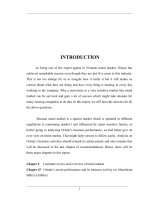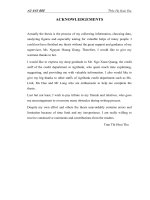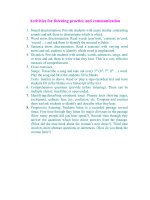Business activities in Oristar Situation and recommendations.doc
Bạn đang xem bản rút gọn của tài liệu. Xem và tải ngay bản đầy đủ của tài liệu tại đây (255.63 KB, 35 trang )
INTRODUCTION
As being one of the expert agents in Vietnam metal market, Oristar has
achieved remarkable success even though they are just five years in this industry.
This is not too strange for us to imagine how it really is but it still makes us curious
about what they are doing and how every thing is running in every day working in
the company. Why a newcomer in a very sensitive market like metal market can be
survived and gain a lot of success which might take decades for many existing
companies to do that. In this report, we will have the answers for all the above
questions.
Because metal market is a special market which is operated in different
regulations to consuming market’s and influenced by many sensitive factors, so
before going to analyzing Oristar’s business performance, we had better give an
over view on metal market. That might help viewers to follow easily. Analysis on
Oristar’s business activities should remark its achievements and also remains that
will be discussed in the last chapter of recommendations. Hence, there will be three
major chapters in this report:
Chapter I: Literature review and overview of metal market
Chapter II: Oristar’s recent performance and its business activity on Aluminium
Billet (Al Billet)
1
Chapter III: Recommendations to improve Oristar’s business results on Al Billet
and the company as a whole.
The report may be limited in scope of study in a way that just focuses on one
major branch of Oristar’s business activities that is Aluminium Billet. Therefore,
there are still many problems needed to be discussed in further researches.
Chapter I: Literature review and Metal
market overview
1.1. Background of import and export activity
1.1.1. Definition of international trade and import-export activity
International trade is the exchange of goods and services across
international boundaries or territories.
Nowadays, International trade is playing a more and more important role in
world economy and taking a higher contribution to GDP of each country.
International trade has been a major driver of global growth and prosperity over the
last fifty years. Barriers to trade have fallen significantly over the last half-century
thank to a lot of agreements on free trade around the world. Hence, International
transactions have been increasing dramatically in recent day. However, besides
international trade there are a lot of supporting services which is aimed at
facilitating cross-border deals such as international payment and transportation.
After looking at definitions, we will go into the role of supporting services for
facilitating international trade in general and im-export activities in particular.
Importation is the activity or process of bringing things into a country from
abroad in order to sell them. Import is any good or commodity, brought into one
country from another country in a legitimate fashion, typically for use in trade.
Import goods or services are provided to domestic consumers by foreign producers.
2
Exportation is the activity or process of selling goods to other countries.
Export is any good or commodity, transported from one country to another country
in a legitimate fashion, typically for use in trade.
Import-Export activity is a key part of international trade in which goods are
transferred between countries. This is a complex process, which required a lot of
other supporting activities such as settling balance, shipping cargo, and buying
insurance policy.
Payment is one of the most vital elements of any sale contract because it is
related to the primary aim of deals. That is benefit. Therefore, whether doing
business domestically or internationally, buyers and sellers have certain basic
objectives when they settle upon a mutually acceptable method of payment:
• Buyers want to receive the goods they order.
• Sellers want to be paid the agreed upon price in a timely manner.
In the past, payment by cash was the most popular in every deal but today
when international trade are stepping at much higher levels and cash payment has
loss its position in international trade. Instead, there are a plenty of different terms
of payment used in settling balance between buyers and sellers in international sale
contracts. Letter of credit (LC)
1
has been the most popular terms of payment in the
world trade today. It is because LC is the safest way for both buyer and seller of
receiving cargo and getting back money. Besides, other terms such as documentary
collection, open account and advanced payment have also been key tools of
international settlement. In brief, payment services provided by banks are playing a
vital role in fulfilling the major duty of payment in any sale contract.
1
A letter of credit is a document issued mostly by a financial institution which usually provides an
irrevocable payment undertaking (it can also be revocable, confirmed, unconfirmed, transferable or others
e.g. back to back: revolving but is most commonly irrevocable/confirmed) to a beneficiary against
complying documents as stated in the Letter of Credit.
3
Transportation is also an essential part of international trade. It is the
movement of goods from one place to another. However, it is just happened to
physical sale contracts, which state that goods must be transferred from one country
to another. It is not a long time ago when international transactions could not reach
between the dealers at far distances. However, a long with the development of world
trade, transportation services has had breakthrough jumps. Today, nearly all
human’s innovation in transport has been applied to cargo transportation among
countries and it seems that there is no where in the world that could not be reached
by transporter. That is really a big support to boosting international trade.
In summary, basic definitions of international trade especially im-export
activity and other supporting services have been covered briefly. Hopefully the
background will be helpful for later analysis.
1.1.2. Definition and importance of Agent
As we have had a look at the importance of international trade in the last part,
this part we will explain more about one of factors that help to facilitate
international trade and it is related directly to the analysis in next chapters. That is
the role of an agent. Let’s look at definition first, and then we will discuss more
about its role in and relation to international trade.
Agent is an individual or firm authorized to act on behalf of another (called
the principle), such as by executing a transaction or selling and servicing an
insurance policy. The agent does not assume any financial risk in the transaction, as
a dealer would.
4
According to the above definition, there is an important point that an agent acts
on behalf of another and take no risk for any financial problem with the activity.
Because an agent does not take title to the good, he won’t have to bear financial
risks but can not benefit the differences in price of goods. However, an agent is
paid a commission for the service he offered to the principle. The commission is
usually a percentage of the value of goods or services. These are some key points of
an agent on theory.
Recently, the international trade has been expanding aggressively thank to free
trade policies of countries, which also facilitates oversea agent activity. Basically,
the appearance of agent is to help trade flow smoothly and easily. Particularly, an
agent provides a service of representing another on doing certain actions following
his principle’s instructions. Agent’s activities not only cut down cost and time in
case of two-side deals but also help the seller update the market information. For the
buyer, he would benefit on the availability of goods or services that the agent
provides on behalf of his principle. If there is no agent standing between the buyer
and the seller, the trading process must take more time and affords for both the
buyer and the seller. However, once an agent participates in the process, the
problem will be solved easily and international transactions would flow smoothly.
In return, the more international trade develops, the greater opportunities it will
create to oversea agent activity. Hence, we might come to a conclusion that
international trade and oversea agent activity have a reciprocal relationship. In
following chapters, we will work on the real situation of Oristar and see the relation
between them more specific.
1.2. Overview of metal market
1.2.1. World metal market
5
Before going in company analysis, we should have an overview on metal
market in general to get the basic knowledge on how the market is organized and
operated. In addition, market characteristics and trends are also among focuses.
Metal market has its own rules which are very different from others. One of
the reasons is that metals are special goods, which follows only market supply and
demand. There are many factors affecting to metal price. The fluctuation in price of
one metal will have widespread influence on the materials, semi-products, and
finished products used the metal as well. The movement in metal price is presented
on metal exchanges such as LME (London Metal Exchanges), Comex (Commodity
Exchange).
2
These markets are the guide line for all suppliers to make their own
price because price of metals, which are inputs for their production, are reflected on
such metal exchange markets. Hence, if there is a small change in price of one metal
in LME, for example, it will lead to a succession of changes in price of all materials
and products made from the metal.
Because metal market is very highly organized and operated on market supply
and demand through 24-hour transactions, it has been attracting more and more
buyers and sellers to make deals in the market. The more deals the metal exchanges
carry out, the more exact it reflects on the price of metals regarding to market
supply and demand. Studying the relation of the two giants in the world metal
market, LME and Comex might explain clearer.
Today, LME and Comex are the two world biggest metal exchanges. Each one
covers a large part of the world. For example, LME covers EU, Middle East and
some part of Asia and Africa while Comex covers all America, Australia and some
where else. Even though it seems that the two metal exchanges are fiercely
competing to each other, they actually are supporting each other. It is because there
2
The leading U.S. exchange for metals futures and options trading
6
is difference in time-belt between New York and London, so working time of each
market is different, which enable suppliers and manufacturers around the world to
expand the opportunities on booking price by using both prices of the two markets.
In particular, they might decide to use LME price during the working day of LME
but once LME close, they turn to use Comex price until this market close. Hence,
the quotation period
3
will be expanded and it appears more opportunities for dealers
in choosing price. Moreover, regardless of physical distance, all suppliers and
manufacturers can still use LME or Comex price as a fix cost in their pricing. Later
we will go in more detail. Although both LME and Comex have big influence to
metal market in general, LME has still been the leader in metal market. In this
report, we will focus on analyzing the most typical metal exchange-LME.
LME has been the world biggest metal exchange since it was established 130
years ago at the centre of London. It is the world’s premier non-ferrous metals
market offering futures and options contracts for aluminium, copper, nickel, tin, zinc
and lead plus two regional aluminium alloy contracts. The Exchange provides a
transparent forum for all trading activities and as a result helps to ‘discover’ what
the price of material will be months and years ahead. This helps the physical
industry to plan forward in a world subject to often severe and rapid price
movements. Such is the liquidity at the Exchange that the prices ‘discovered’ at the
LME are recognized and relied upon by industry throughout the world. The prices
keep moving all the times reflecting supply and demand of materials by industries.
In 2006 LME achieved volumes of 87 million lots, equivalent to $8,100 billion
annually and between $35-45 billion on an average business day. Despite its
location in London, the LME is a global market with an international membership
and with more than 95% of its business coming from overseas
4
.
3
Quotation period: period that the seller allows the buyer to book price for the sale contract they has
signed.
4
/>7
Being a 24-hour market, transactions on the LME are taken place through an
inter-office telephone market and LME Select, an electronic trading platform. Each
day the LME announces a set of official prices, which are determined from the
open-outcry trading. This trading is highly liquid and trade and industry has
confidence that they properly reflect the current supply/demand situation. These
prices are used by industry worldwide as the basis for contracts for the movement of
physical material throughout the production cycle. Normally, suppliers set their
price based on LME current price + Premium. Premium includes all costs such as
production cost, transportation cost, extra costs and profit. The Premium is the only
one that makes different among suppliers and their competitiveness in price.
However, quality of material is one of the significant factors to compete in such
sensitive market. Materials which are listed on LME must be satisfied standards
created by LME or equivalent international standards such as JIS (Japanese
International Standards), CDA/ASTM (USA), BS (UK), DIN (Germany), ISO
(international Standards). Therefore, LME’s role here is not only a guide line for
setting prices but a common standard on evaluating quality of materials.
In summary, metal market is a high standardized and liquid market which is
directed by Exchanges such as LME and Comex. However, the LME has been
keeping the position of a world leader thank to its long history and high prestige.
The two most important roles of LME are providing prices due to the current
supply/demand situation and building quality standard control.
1.2.2. Metal market in Vietnam
As a part of world metal market, Vietnam market has operated on the same
regulations of the world metal market. That means Vietnamese industries depend on
LME or Comex prices to decide domestic prices. Nevertheless, supply and demand
in Vietnam might not go with the trends in the LME or Comex because factors
influenced on domestic prices are different to the world market’s.
8
One of the remarkable characteristics of Vietnam market is the isolation
among manufacturers in the same industry. Until now, there hasn’t had an official
organization in Vietnam which gathers all manufacturers in the same industry and
operates on the purpose of protecting domestic industry. That’s why market trends
in Vietnam usually move adversely for both the manufacturers and the industry. It is
caused by the price wars among manufacturers, which makes metal prices go down
much while the world prices still remain or just suffer a small reduction. Such
tough and endless competitions have led not only to the failure of manufacturer
individually but also the whole domestic industry.
For example, the situation of aluminium billet market in Vietnam. Recently,
world aluminium price has been increasing each day from about $2346 to
$2567/MT
5
within first three weeks of October, 07. However, domestic aluminium
price has been continuously rising in the period. The reason is that Vietnamese
aluminium manufacturers are stuck in a marsh of price wars, so the domestic price
trend goes in a contrast way with the world trend. The roof of the problem might
come from the individual behavior of manufacturers which distorted the real supply
and demand on the market and led to the unbalances in price between Vietnamese
aluminium billet market and the world market. Hence, it appears an urgent demand
of establishing an organization which is responsible for directing and orienting the
market and preventing such continual price wars as it is being this time in Vietnam.
Besides, another reason is that in Vietnam there are hardly any giant in
aluminium industry who may have a big influence on the whole market or control
the market. It is a fact that almost all big aluminium manufacturers in Vietnam have
had similar performance and equal impact to the market. That’s why the
competition in the market has become so tough.
5
/>9
Some big aluminium manufacturers in Vietnam are Do Thanh, Dong Anh,
Song Hong, Scancom, Quang Binh, Nam Hai, and Dien Bien. There are 60 % of
these companies which have ever made deals with Oristar
6
on aluminium billet.
However, from time to time the business relationships have some changes.
Oristar has to face with the competition coming from some trading companies
at this moment such as Tran Phu electric Company, Van Xuan Co., Ltd and Tuong
Thanh trading Company. Despite the fact that Oristar still has some competitive
advantages over its rivals, there are internal problems that they should improve. In
next chapters we will discuss in more detail.
6
Oristar: which will be discussed in following chapters
10
Chapter II. Oristar’s overall performance and its
Business activity on Aluminium Billet
2.1. Company profile
2.1.1. Foundation and organization
Oriental star Import-Export Co., Ltd (shortened form as Oristar.Co. Ltd) was
established in 2002 by Mr. Pham Quoc Hung. Oristar has two offices in North and
South of Vietnam. Head office is located at No.2, Tran Thanh Tong, Hanoi and
another branch at 51/60 Cao Thang, 3 ward, HCM city. The number of employees
has increased from 30 to 50 people within 2 years from 2005 to 2007.
Oristar has two Business departments at the two offices, one Im-Export
department, and one finance department at the head office in Hanoi only. Main
business activities of Oristar are carried out in the close coordination of these
departments that will be focused later.
2.1.2. Introduction to Oristar’s main business activities
Oristar is a trading company special in non-ferrous materials and semi-
products. There are two main business activities carried out by Oristar. First, it
imports and resells semi-products such as copper Bus Bar, tube, aluminium plate
and sheet, anodized aluminium coils and metal ceilings to domestic market.
Second, Oristar performs as exclusive sales agent for many suppliers of non-ferrous
metals in Vietnam such as Formosa (Malaysia) for Aluminium Billet, Hydro
(Norway) for Primary aluminium ingot, MAA (Australia) for Aluminium alloy
ingot, Sterlite (India) for Copper Cathode. Even though importing and reselling
activity takes more time and affords, it is the activity of being sale representative
that brings more money to the company. The commodities sold on behalf of
11
suppliers almost are materials for manufacturing industries. For example,
Aluminium billet is input for extrusion industry, Copper Cathodes is used popularly
as input for cable and electronic industry. Oristar obtains a commission based on
the quantity of the materials it sold and on the agreement between Oristar and its
suppliers. Among all materials Oristar sells on behalf of foreign suppliers in
Vietnam, Aluminium Billet is the most strategic one with highest annual revenue.
In the next part, we will focus more on Aluminium Billet in analyzing Oristar’s
business activities.
2.1.3. Oristar’s market share and position in the market
Through five years running business, Oristar has created a good prestige in
Vietnamese metal market especially for Aluminium Billet and Copper Cathodes.
Today, there are about 30 % of extruding companies in Vietnam which have
imported aluminium billets through Oristar. For other materials such as copper
cathodes, primary aluminium alloy ingot and secondary aluminium ingot, Oristar
has also built rather stable networks among oversea suppliers and domestic
companies, which gives it a position in the market.
Oristar’s role in the process is like a broker, who connects the buyers and the
sellers together. However, Oristar has bigger liability to both suppliers and
customers. Particularly, it has to follow up each sale contract and if there is any
failure, Oristar has to co-ordinate in solving problem with both sides. Sometimes,
Oristar ought to compensate for trivial claims from buyers for maintaining good
business relationships with its suppliers. One of the most significant responsibilities
of Oristar as being agent is selling materials as much as possible to local customers.
Each year Oristar has to meet target revenues set by its suppliers, which is a good
way for the suppliers to evaluate performance of their agent and also adjust
commission rate to the agent accordingly. The strength of Oristar here is that it
12
knows very well about Vietnamese market, where is rather strange to foreign
suppliers to approach. For local customers, they can make advantage of Oristar’s
expertise knowledge of metal market, which will support much for their decisions
making about where, when and from whom they should import. In short, Oristar
plays a very importance role in connecting foreign suppliers and domestic customers
and keeping the international transactions between them flow smoothly and easily.
In general, company profile has given the key information about Oristar, its
organization, market share and major business activities. In the following part, we
will go in more detail Oristar’s business performance through 2003 to 2006.
2.2. Business performance of Oristar from 2003 to 2006
2.2.1. Analysis on revenue during the period of 2003-2006
As mentioned Oristar has been started since 2002, until now it has been
running for five years. The total revenue through years was increasing dramatically.
The following is the table of revenue from 2003-2006:
Total revenue between 2003 and 2006 (billion VND)
Year 2003 2004 2005 2006
Revenue 20.5 32.5 127 135
Source: Data issued by Oristar finance department 2006
The second year after setting up, the revenue increased about 50% in
compared with 2003. The revenue broke record in 2005, which was 4 times bigger
than 2004. The increasing trend has still continued in 2006 with a slight rise. All in
all, Oristar’s revenue has continuously increased through 5 years especially in 2005
13









